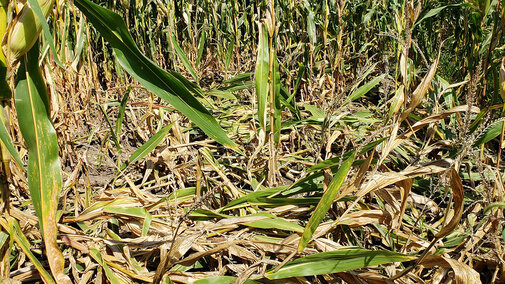Extremely stressful growing conditions occurred during much of 2019 in Nebraska, including wet conditions early that delayed planting, record rainfall during July and August, and continued wet conditions into September. Stressful growing conditions anytime during the season can lead to poor plant health and subsequent impacts on late season stalk quality. Corn plants in many areas are showing poor stalk quality that may indicate a need to scout fields to determine which may need to be harvested first or earlier than planned to avoid losses due to lodged corn.
Stalk rot and lodging (Figure 1) was evident as early as August in some York, Seward, Clay, and Nuckolls county cornfields, particularly in those along waterways that experienced flooding earlier in the season. In Boone, Nance, and Platte counties, weak stalks and stalk rot was confirmed to some extent in 90% of cornfields surveyed recently. This number indicates the presence of weak stalks/stalk rot, but does not indicate the severity within the field. This would need to be categorized by completing the push test.
Flooding and wet conditions in the spring delayed planting for many producers across the state. Late planting generally reduces corn yield, but, it can also impact plant height, leaf number, ear height, stem diameter, and other plant characteristics.
The effects of late planting potentially causing thinner stalks with ears set higher on plants puts them at greater risk for lodging. In addition, corn diseases, such as those in recent samples submitted to the UNL Plant and Pest Diagnostic Clinic from across Nebraska, will contribute to stalk problems. Many of the diseases developing in Nebraska cornfields are stalk rot diseases, caused by common fungal pathogens decaying the internal pith tissue inside the stalks.
Stalk rot diseases occur every year in cornfields. Stalk rot disease can prematurely kill plants causing direct impacts to yield. Greater incidence and severity of stalk rot diseases can also have a serious impact at harvest as plants may lodge, falling to the ground out of reach of combine heads during harvest.
The risk of stalk rot diseases is increased in some fields, especially when:
- Leaf diseases, such as gray leaf spot, southern rust, Physoderma brown spot, and others, are severe. Loss of leaf area can lead to stalk cannibalization as the plant fills grain.
- Plants were in standing water.
- Stalks were wounded due to hail and/or insect damage, allowing for infection by some pathogens.
- Susceptible hybrids were planted.
- Soil fertility challenges – too much or (especially) too little nitrogen that may have leached away during wet conditions.
- Higher than recommended plant populations.
- Fields have a history of stalk diseases, especially in continuous corn with carryover fungal inoculum from the previous season(s).
Diseases of Concern this Year
Physoderma brown spot (Physoderma maydis) does not cause a true stalk rot disease, but spores can accumulate and infect at nodes, weakening them. Infected nodes may become brittle and snap when pushed, revealing darkly discolored stalk rinds (Figure 2), often with healthy interior tissue.
The leaf phase of the disease (Figure 3) was common in many Nebraska fields this year. Infection usually occurs earlier in the season when wet conditions at V3-V8 lead to water accumulation in the whorl of plants where infection usually occurs. Lesions on the leaf blades are yellow to brown and on the midrib and leaf sheath they are black. Lesions often occur in bands across the leaves.
Corn hybrids vary in their resistance to the disease, so hybrid selection may help to reduce severity, although brittle stalks may develop in some hybrids with only low incidence and severity of foliar disease symptoms.
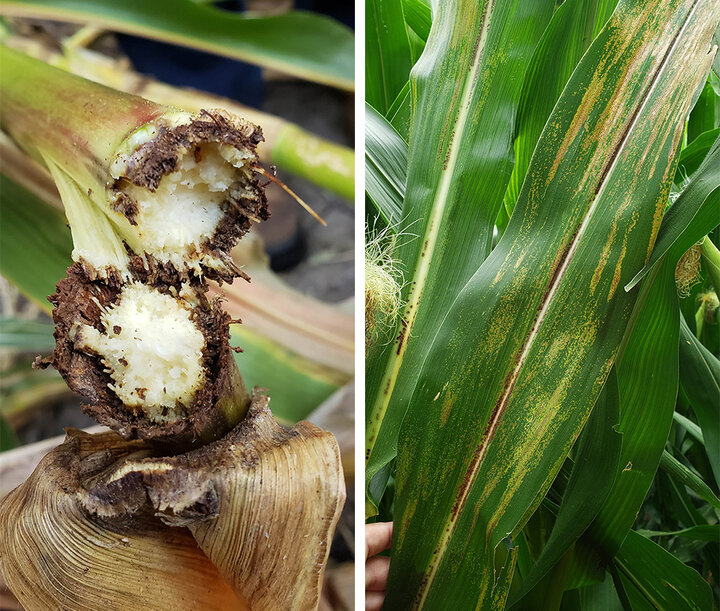
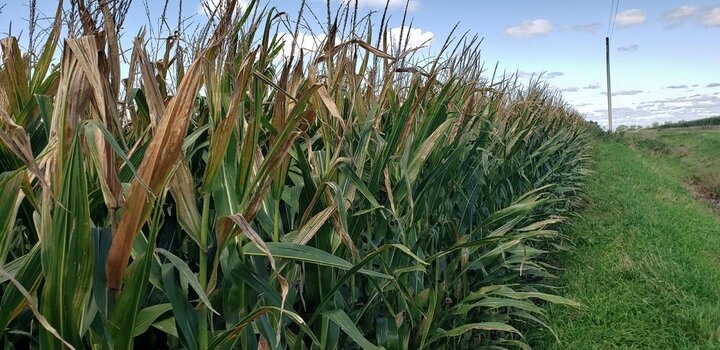
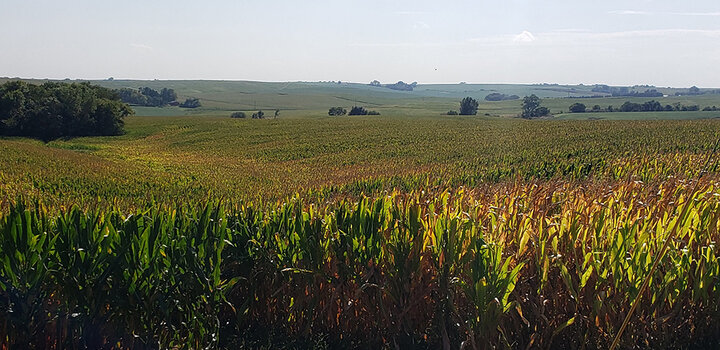
Figures 4 and 5. (L-R) Anthracnose top dieback is a systemic infection that leads to the death of the upper internodes of the plant. Discoloration of leaves and death of the upper plant leading to harvest can also be more common in some hybrids than others and not caused by disease.
Anthracnose stalk rot (Colletotrichum graminicola) is common in Nebraska. The pathogen creates dark, black splotchy lesions visible on the outside stalk rind. When the fungus becomes systemic, a top dieback may occur in nodes above the ear and was common in 2019 cornfields (Figures 4 and 5). Resistance is available in some hybrids for stalk rot, but is not always effective against the leaf blight phase of the disease. Generally, when 10-15% of plants are affected within 60 days of harvest, early harvest may be beneficial to minimize future losses.
Fusarium stalk rot (Fusarium verticillioides) is common in Nebraska. Discolored, softened stalks may have loose strands of vascular bundles inside. White, salmon, or light pink discoloration is common. Stalks may develop brown streaks visible on the outside or evidence of fungal growth or spores, especially on the nodes. Plants may die prematurely. Splitting stalks may reveal discoloration that is in the lower crown/nodes (crown rot) of the plant, resulting in rapid plant death. Generally, when 10-15% of plants are affected within 60 days of harvest, early harvest may be beneficial to minimize future losses.
Gibberella stalk rot (Gibberella zeae) may cause development of dark streaks on the lower internodes of stalks. Close examination may reveal raised, black specks (fungal fruiting bodies called perithecia) on the surface that cannot be scratched off. The pathogen also can cause scab disease in cereal grain and will be more common in crop rotations that include susceptible crops. Dark pink to red discoloration may develop inside stalks. Generally, when 10-15% of plants are affected within 60 days of harvest, early harvest may be beneficial to minimize future losses.
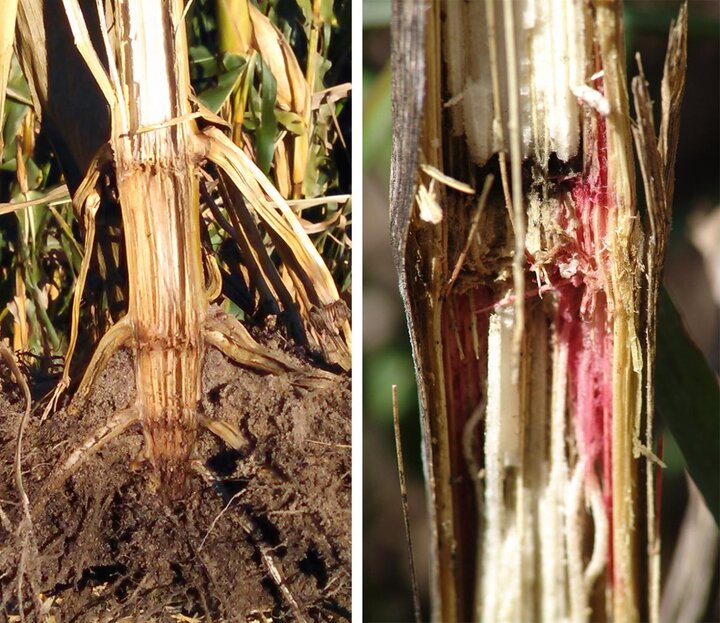
Management
Management of stalk rot diseases depends on the specific disease, making a proper diagnosis key. Discoloration of leaves and death of the upper plant leading to harvest can also be more common in some hybrids than others and not caused by disease.
If submitting suspected stalk rots to the UNL Plant and Pest Diagnostic Clinic, include stalks and crowns. The foliar top dieback that occurs with some diseases is a response to infection and the pathogen cannot be found in foliar tissue. Information on submitting quality samples can be found on the PPDC website.
